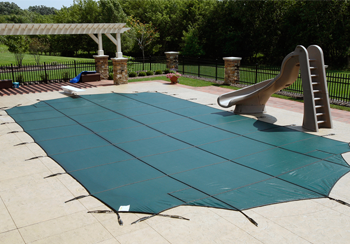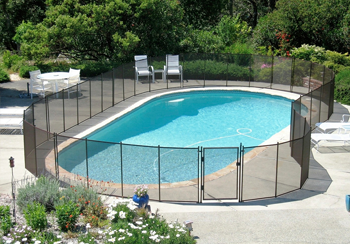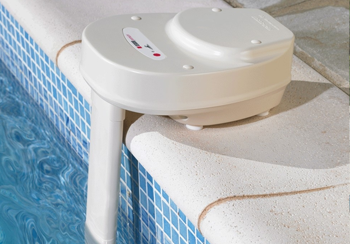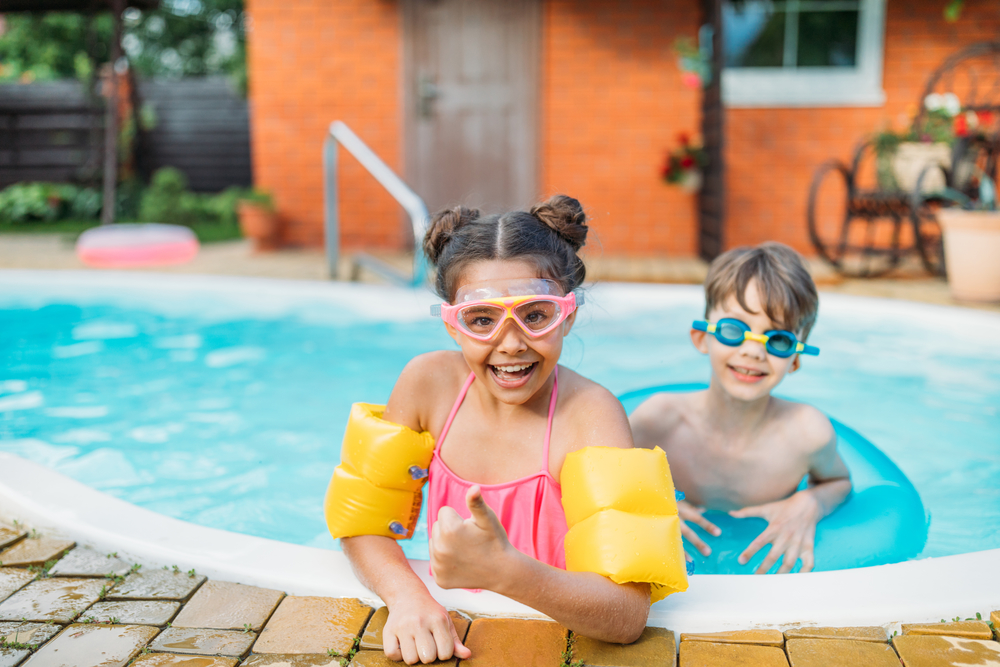With summer right around the corner, let’s talk about pool security and safety equipment available on today’s market.
Safety Covers
A high quality pool cover must meet all the standards of ASTM  International (American Society for Testing and Materials) in order to qualify as a swimming pool safety cover. One of the top standards is that the pool cover must support the weight of 485 pounds within a three-foot diameter.
International (American Society for Testing and Materials) in order to qualify as a swimming pool safety cover. One of the top standards is that the pool cover must support the weight of 485 pounds within a three-foot diameter.
Solid safety covers, which are typically made from vinyl, use an automatic pump to drain rainwater off the surface to prevent a drowning hazard. Tapered safety covers prevent water from pooling in the center and those with mesh panels permit water to drain through the cover. All swimming pool covers should be completely removed while using the pool so there’s no risk of a swimmer getting tangled or trapped beneath it.
Perimeter and Isolation Fences
Most cities require swimming pools to be installed in a fully fenced yard. While you are most likely to install a fence around your yard, the CDC notes that the only safety fence shown to be effective is a four-sided isolation fence with a self-closing, self-latching and child-proof gate. An isolation fence isolates the pool from the house and the rest of the yard on all sides of the swimming pool.
 The Consumer Product and Safety Commission recommends that a swimming pool fence be at least 48 inches high with openings no wider than four inches. To discourage children from climbing the fence, the fence should contain few horizontal bars and not be made of chain links.
The Consumer Product and Safety Commission recommends that a swimming pool fence be at least 48 inches high with openings no wider than four inches. To discourage children from climbing the fence, the fence should contain few horizontal bars and not be made of chain links.
Permanent isolation fences can be made of many materials: wood, metal, or wrought-iron and remain installed for a many years. Other isolation fences—made of plastic mesh or tightly woven material with poles that slide into multiple ground brackets placed around the pool. These types of fences are typically set up for the length of the pool season, then taken down and stored during the off season.
Pool Alarms
There are a wide variety of swimming pool alarm systems, including invisible fences and alarms for gates, doors and windows. For children, there are wearable alarms as well.
Invisible fences on today’s market use laser or infrared technology  to detect when a child or an animal moves or emits body heat in a protected area. The “fence” is created by evenly spaced detectors that form a sensor beam when enabled. When the beam is broken, an alarm will sound. On many of these systems, you can adjust the height so ground-level activity will not trip the alarm.
to detect when a child or an animal moves or emits body heat in a protected area. The “fence” is created by evenly spaced detectors that form a sensor beam when enabled. When the beam is broken, an alarm will sound. On many of these systems, you can adjust the height so ground-level activity will not trip the alarm.
Gate alarms attach to fence gates and utilize a magnetic connection that sounds an alarm when broken.
Other than gate alarms, you can consider installing in-pool alarms. Some alarms attach directly to the pool wall and others float on the water. Both utilize similar technology to warn homeowners when someone or something has entered the swimming pool. Most of these alarms detect motion in the water and are silenced after the user accesses the disarm button located in the control panel. The control panel must be opened with a key or code, making it hard to bypass.
For additional pool safety and security, consider adding alarms to your home windows and doors leading to the pool area.
Wearable Alarms
Wearable alarms attach to a child’s wrist or article of clothing and will sound an alarm if he/she becomes submersed in water or the alarm is taken too far from the main unit’s vicinity.
To provide a safe, fun environment for you and your family, always be sure to remain within an arm’s reach of children and use multiple forms of other safety devices for added protection.




